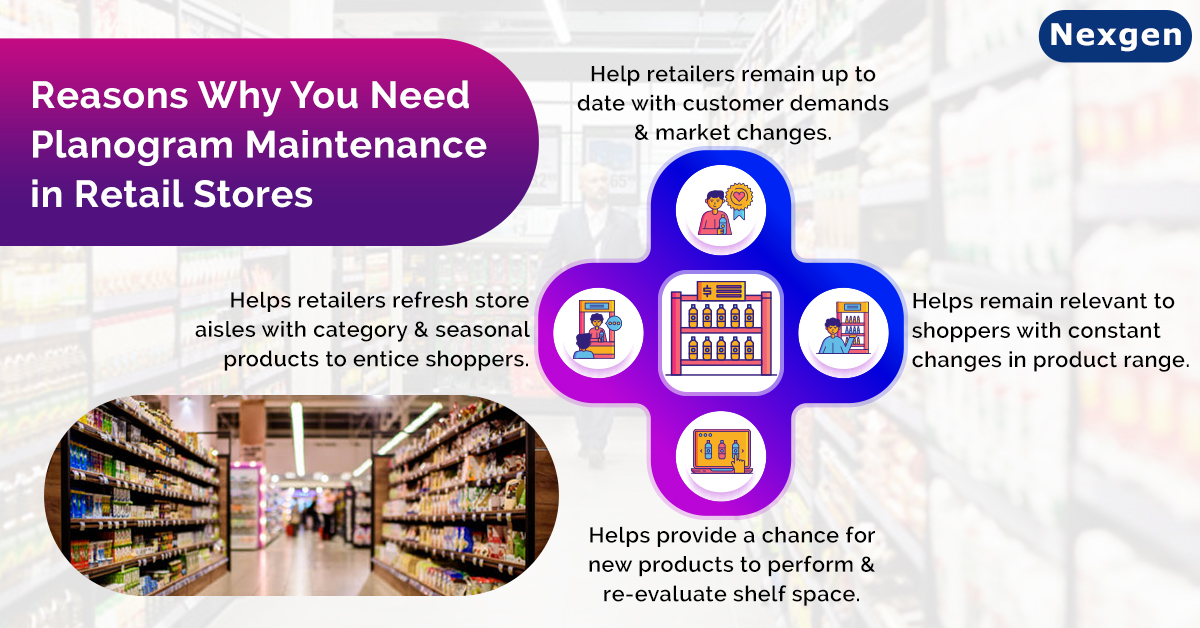It is never a good idea to just create a planogram and then leave it. When built correctly, a data-driven planogram needs to be reviewed or updated frequently in order to be successful in retail.
Successful retailing depends on good merchandise of items. For example, Imagine a shopper visits a store regularly to purchase one product. Through their visits, they have become more familiar with the aisles and know the exact location of that item on the shelf. When they know where the product is located, they become blind to other products in the store, walking right past them without even the slightest glance. A change in store layout forces them to pay attention to other things in the store. Credit for these unplanned purchases goes to planogram maintenance. Planograms are visual merchandising tools that retailers use to help their in-store staff in shelf planning, choosing specific products to display on shelves, and even updating the shelf to increase sales.
What is Planogram Maintenance?
It involves maintaining the planograms you built over time to make sure they remain up to date with consumer demand and market changes. You cannot create a planogram once and assume it to function indefinitely. When necessary, you must update the planogram in a pertinent manner. Following are a few reasons why you need planogram maintenance in retail stores:
- Constant changes in your product range: The primary reason why planogram maintenance matters the most is the continuous changes in your product range. At least, they should, if you want to remain relevant to your shoppers and provide them with the products they want. That means adding and removing items from your planogram when necessary. For example, if a product is not performing well on shelves, you should either remove it or reduce its facings. If there is any gap on the shelf, replace it with other items that will offer you better sales.
- When your retail data does not stay the same: The second reason why planogram maintenance is critical is due to the changes in shopping behavior of customers. As a result, your sales data changes too. Your customers will buy more of one item and less of another. It can be due to a change in season or because a product has reached the end of its lifecycle and is no longer available. Whatever the reason, as customer behavior changes, you need to update your planograms and their layout accordingly. Otherwise, it can turn the items into dead stock in dwindling sales and profit loss.
How Often Should You Update Planograms?
The general rule is to review and update planograms once every quarter or every six months. And updating planograms too often results in wastage of time and resources. It is because, every time you update the planograms, you flush in new data to ensure that the items on your shelf plan are meant to be there and have the right space allocation. If you update monthly, it can result in skewed data, and it will give you the wrong results. Other than that, consider the following factors that will influence how often you need to update your shelf plans:

- It depends on the category: The first factor that demands updating your planograms is the change in category itself. Let’s say, for example, you stock woolen jackets. For this category, you would probably look to refresh your store aisles once a year because you know woolen jackets pick up sales during winter and drop off during summer. That would be the same for other retailers. Refreshing your planograms once or twice a year is a best practice to boost sales. Since there are always new lines available, it would be a good idea to give new products two to five months to perform, and you can re-evaluate their shelf space later.
- It depends on the seasonality: A second factor, which is linked to the first one, is seasonality. With a seasonal category, you need to update the planograms throughout the season. For example, you would not update your winter cream planogram during the middle of the summer because it would not make sense. You also update the planograms during seasonal periods such as Halloween, Christmas, New Year or Valentine’s Day. Once the period or event is over, you would remove those SKUs and give the space to other items for better sales. For instance, you will remove all the gift cards you displayed during the New Year once it's over.
Overview of Nexgen POG
Nexgen POG is a robust and user-friendly cloud-based visual merchandising tool. It is designed for quick and efficient planogramming with minimal effort. Planogram in retail can be designed by easily dragging and dropping the products. The multi-device compatibility feature of POG allows you to obtain, share and edit planogram on any device, including your phone. It helps in designing store-specific planograms for increased product visibility and sales.
Get Your Free Trial Now!